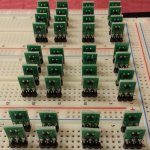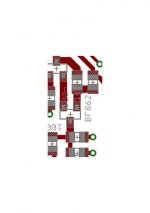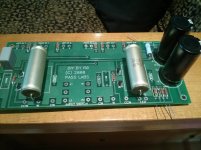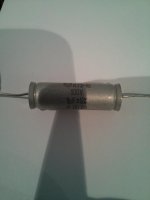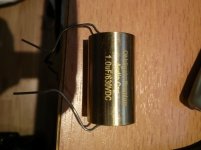I paid 8 USD for 200 pieces (including 600 number of angled pins below), plus 5 USD for shipment - averaging .065 USD per piece include shipment, from the Chinese online market called TaoBao.
Anyway, they're cheap enough so eBay is fine 🙂

Anyway, they're cheap enough so eBay is fine 🙂

First time to solder SMD parts, it turns out to be easier than I thought. I have a question about idss matching though.
I've measured the Idss (@12V, as I have no 10V source around) of 40 pieces of BF862, and got some matched pairs. I would like to know if it's better to use a loosely quad-matched for the 2 channels of B1, or 2 closely matched pairs.
Idss of Quad matched: 14.89,14.93,14.98,14.99mA
Idss of 2 matched pairs: 15.81,15.81 and 15.90,15.91mA
I've measured the Idss (@12V, as I have no 10V source around) of 40 pieces of BF862, and got some matched pairs. I would like to know if it's better to use a loosely quad-matched for the 2 channels of B1, or 2 closely matched pairs.
Idss of Quad matched: 14.89,14.93,14.98,14.99mA
Idss of 2 matched pairs: 15.81,15.81 and 15.90,15.91mA
Attachments
Use two closely matched pair, BUT put one pair in the "upper" position of each channel, (signal device) and the other pair in the "lower" (current source) position.
Thanks 6L6 for the answer. Just to be sure I understand properly, do you mean it would be something like:
Left channel: signal - 15.90, ccs - 15.81
Right channel: signal - 15.91, ccs - 15.81
Left channel: signal - 15.90, ccs - 15.81
Right channel: signal - 15.91, ccs - 15.81
Thanks Salas, Andrew mentioned the same before. I'll probably stick a small piece of copper foil on them with thermal glue.
@18 degC room temperature and open space, running them @12V and idss for an hour, they aren't even warm. But it's probably very different in the summer, in a small case together with a shunt regulator.
@18 degC room temperature and open space, running them @12V and idss for an hour, they aren't even warm. But it's probably very different in the summer, in a small case together with a shunt regulator.
If they are not even warm then adding 30 degrees of summer heat is only going to make them warm.
If they are not even warm then adding 30 degrees of summer heat is only going to make them warm.
150mW on a BF862 with 1mm traces and Pads from the resistor nearby heated to 25°C above ambient. Should be no problem even in a chassis.
If you have this power in a TO92 it runs hotter.
Thanks both 🙂
AULT / SL POWER / RESPIRONICS MEDICAL POWER SUPPLY
FYI, the Ault 18V 90W medical power supply model MW116 is now the SL Power MENB1090 also sold as Philips / Respironics 900-150.
FYI, the Ault 18V 90W medical power supply model MW116 is now the SL Power MENB1090 also sold as Philips / Respironics 900-150.
Attachments
Last edited:
All of those caps are good choices for a great price.
Thanks for the input.
What are peoples experiences with mix and matching Caps in the B1. For example if I mix the 10uf K73's with the 1uf Obligattos??
There are more than a few that do not recommend paralleling many capacitors for a signal coupling duty.
I wonder if mixing lots of different dielectrics will give an average set of parameters that will pass signal cleanly?
what about trying a mix of polypropylene + polystyrene + teflon + polyphenylene sulphide.
Then one could vary the parameters by changing the relative values of each type.
BTW,
what is the objection to using multi-paralleled coupling capacitors?
I wonder if mixing lots of different dielectrics will give an average set of parameters that will pass signal cleanly?
what about trying a mix of polypropylene + polystyrene + teflon + polyphenylene sulphide.
Then one could vary the parameters by changing the relative values of each type.
BTW,
what is the objection to using multi-paralleled coupling capacitors?
I should clarify. I didn't mean I wish to "Parallel" the caps. What I meant is using the Russian K73 10uf caps in their appropriate place and Obligatto 1uf in theirs instead of ,for example, using K73's all around.
Last edited:
- Home
- Amplifiers
- Pass Labs
- B1 Buffer Preamp
